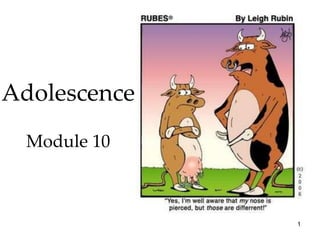
Adolescence
- 1. Adolescence Module 10 1
- 2. Developing Through the Life Span Adolescence Physical Development Cognitive Development Social Development Emerging Adulthood 2
- 3. Adolescence Many psychologists once believed that childhood sets our traits. Today psychologists believe that development is a lifelong process. Adolescence is defined as life between AP Photo/ Jeff Chiu childhood and adulthood. 3
- 4. Physical Development Adolescence begins with puberty (sexual maturation). Puberty occurs earlier in females (11 years) than males (13 years). Thus height in females increases before males. 4
- 5. Primary Sexual Characteristics During puberty primary sexual characteristics — the reproductive organs and external genitalia — develop rapidly. Ellen Senisi/ The Image Works 5
- 6. Secondary Sexual Characteristics Also secondary sexual characteristics—the nonreproductive traits such as breast and hips in girls and facial hair and deepening of voice in boys develop. Pubic hair and hair in armpit grow in both sexes. 6
- 7. Brain Development Until puberty neurons increase their connections, however, at adolescence selective pruning of the neurons begin. Unused neuronal connections are lost to make other pathways more efficient. 7
- 8. Frontal Cortex During adolescence neurons in the frontal cortex grow myelin which speeds up nerve conduction. Frontal cortex lags behind limbic system development. Hormonal surges and limbic system may explain teens’ occasional impulsiveness. 8
- 9. Cognitive Development Adolescents’ ability to reason gives them a new level of social awareness. In particular they can think about: 1. Their own thinking. 2. What others are thinking. 3. And think about what others are thinking about them. 4. How ideals can be reached. Criticize society, parents and even themselves. 9
- 10. Developing Reasoning Power According to Piaget, adolescents can handle abstract problems, i.e., they can perform formal operations. Adolescents can judge good from evil, truth and justice, and think about God in deeper terms. William Thomas Cain/ Getty Images AP/Wide World Photos 10
- 11. Developing Morality Kohlberg (1981, 1984) sought to describe the development of moral reasoning. Kohlberg posed moral dilemmas, like “Whether a person should steal medicine to save a loved one’s life,” to children and adolescents and found stages of moral development. AP Photo/ Dave Martin 11
- 12. Moral Thinking 1. Preconventional Morality: Before age 9, children show morality to avoid punishment or gain reward. 2. Conventional Morality: By early adolescence social rules and laws are upheld for their own sake. 3. Postconventional Morality: Affirms people’s agreed- upon rights or follows personally perceived ethical principles. 12
- 13. Moral Feeling Moral feeling is more than than moral thinking. When posed with simulated moral dilemmas the brain’s emotional areas only lighted up when the nature of the dilemmas were emotion driven. 13
- 14. Moral Action Moral action involves doing the right thing. People who engage in doing the right thing, develop empathy for others, self-discipline for themselves to restrain their own impulses. 14
- 15. Social Development 15
- 16. Psychosocial Stages of Development • Each stage is characterized by a different conflict (task) that must be resolved by the individual. • Conflicts arise when the environment makes new demands on people. • The person is faced with a choice between two ways of coping with each crisis, an adaptive, or maladaptive way. • Only when each crisis is resolved will the person have the strength to deal with the next stage.
- 17. Trust Vs. Mistrust (0-1yr) • Infant dependent on adults to meet all needs. • When needs are met in consistent manner the infant begins to trust. • She/he has resolved the “conflict” of discomfort by trusting that an adult will help.
- 18. Autonomy Vs. Shame and Doubt (1-3 years) • Testing independence by assuming more “self- responsibilities”. • “ME DO IT!” • Child wants to do everything for him/herself. (Feed, dress, toilet) • Adult needs to provide guidance and support for the increasingly independent child
- 19. Initiative Vs. Guilt (3-5) • Child is ready to take initiative in planning some actions. • Wants to develop an idea and see it take place. • Adults encourage creativity and support child in trying out his/her ideas.
- 20. Industry Vs. Inferiority (6-12) • Child must deal with demands to learn new skills or risk a sense of inferiority, failure, and incompetence. • Important to help children set realistic goals and maintain motivation to reach goals.
- 21. Identity Vs. Role Confusion (teens-early 20s) • Identity achievement reached through “selective repudiation and mutual assimilation of childhood identifications.” (Erikson, 1968) • Adolescent must achieve an identity in occupation, sex roles, politics, religion.
- 22. Forming an Identity In Western cultures many adolescents try out different selves before settling into a consistent and comfortable identity. Having such an identity leads to forming close relationships. Matthias Clamer/ Getty Images Leland Bobble/ Getty Images 22
- 23. Parent and Peer Influence Although teens become independent of their parents as they grow older, they nevertheless relate to their parents on a number of things including religiosity and career choices. Peer approval and relationships are also very important. 23
- 24. Emerging Adulthood Emerging adulthood spans from 18-25 years. During this time young adults live with their parents and attend college or work. They marry on average in their mid-twenties. Ariel Skelley/ Corbis 24
- 25. Adult Stages • Intimacy vs. Isolation: Young adulthood, must develop close relationships. • Generativity vs. Stagnation: Middle adulthood, must find some way to satisfy and support the next generation • Ego Identity vs. Despair: Late adulthood, sense of acceptance of oneself as one is and of being fulfilled.